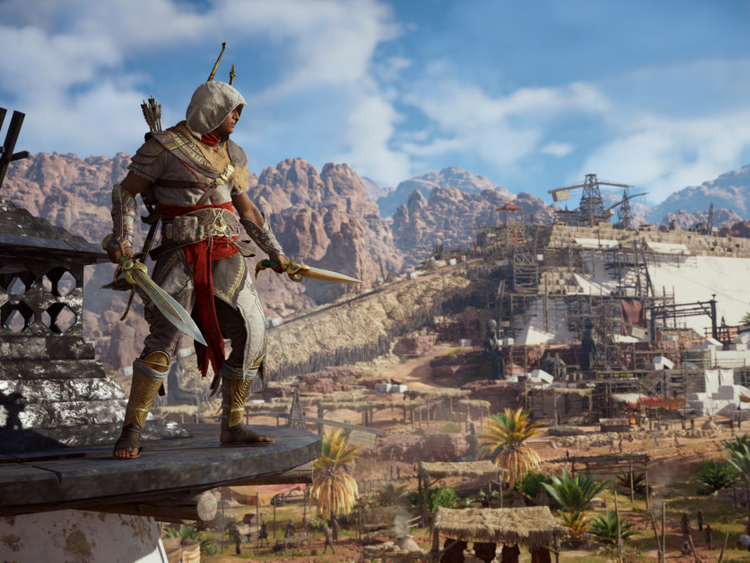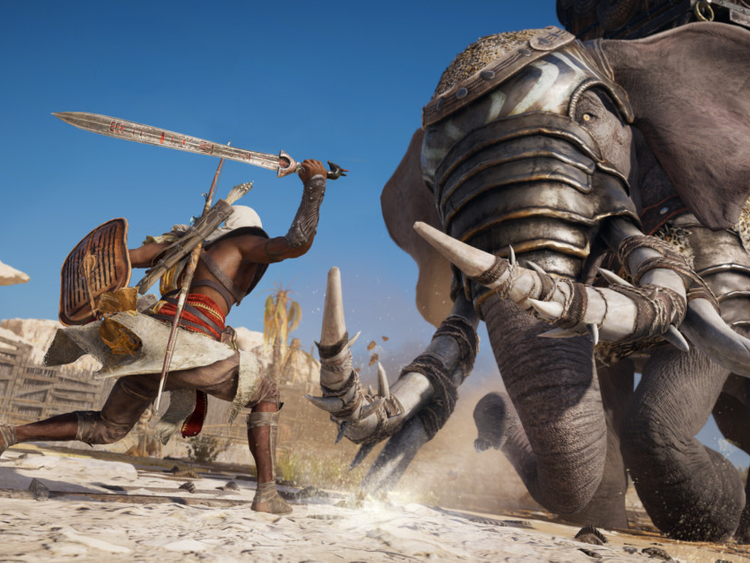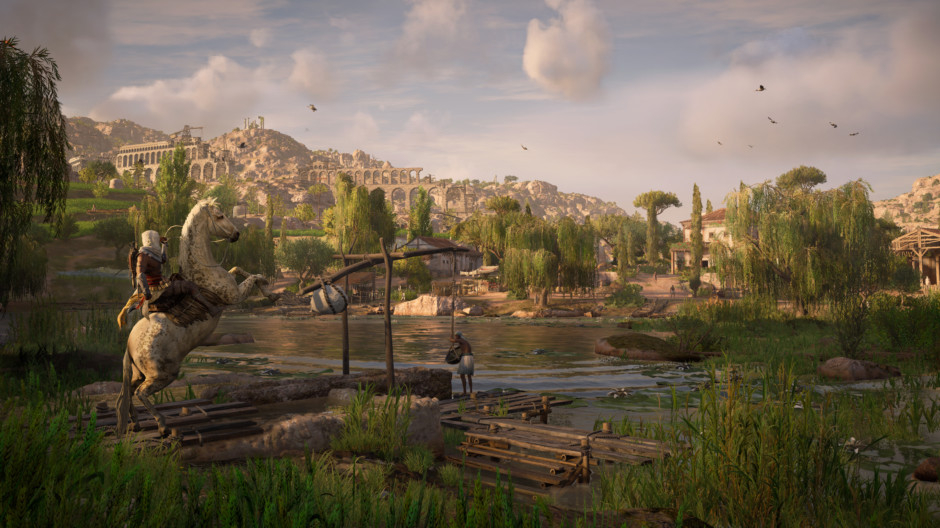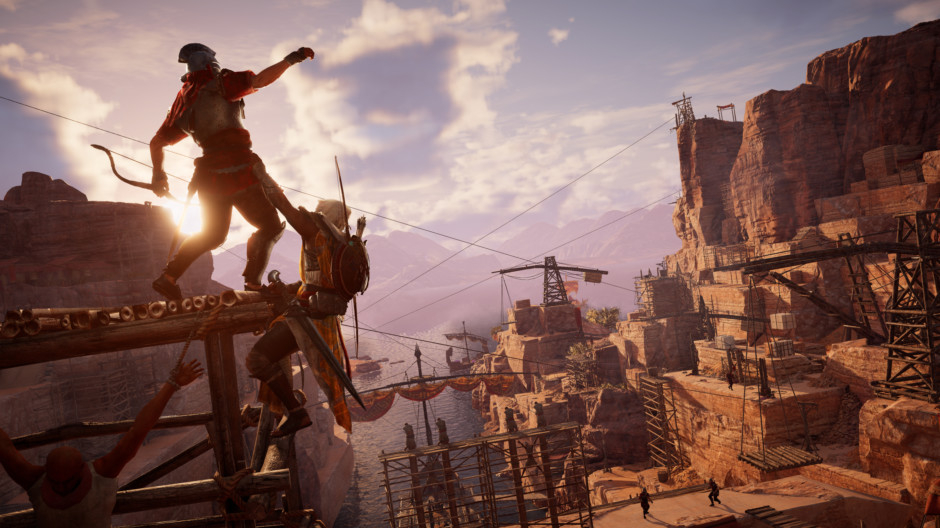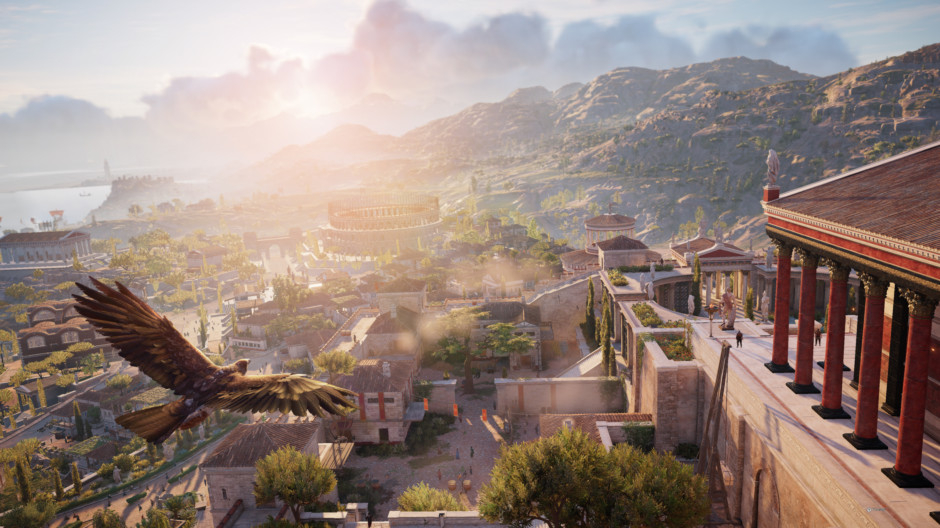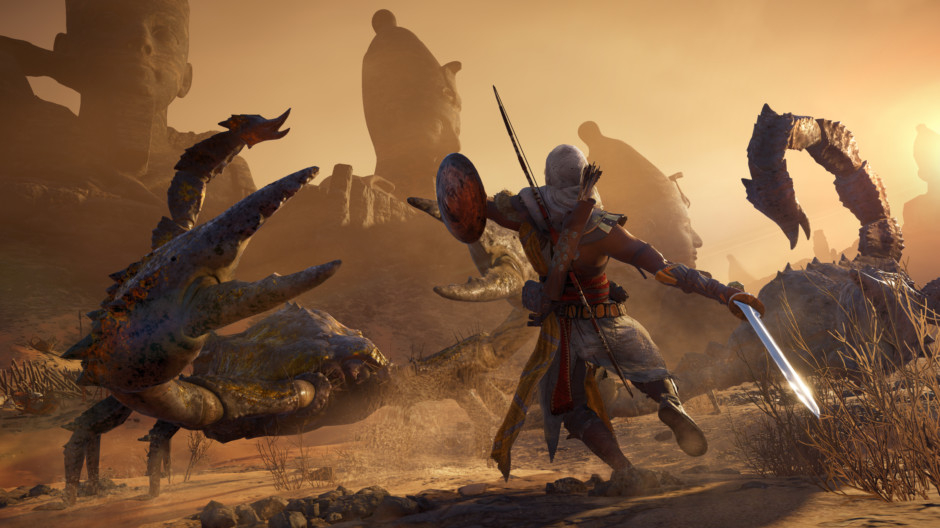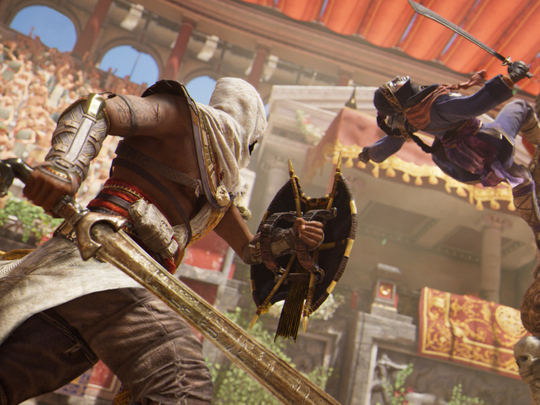
In BC49 Cleopatra ascended to the Egyptian throne amid enormous geopolitical upheaval and radical change. With the final war of the Roman Republic brewing, the period has proven hugely influential in fine art, theatre and film, from Shakespeare to Hollywood. But later this year it may be subject to its most rigorous investigation yet: a video game.
Out at the end of October, Assassin’s Creed: Origins, follows the story of Bayek, a military officer looking to protect his people as Julius Caesar’s Roman army threatens invasion. The game is set to feature a vast open-world recreation of ancient Egypt, featuring several cities as well as stretches of wilderness and ocean. As with all titles in the series, historical events and figures are set to figure, but this time, the gargantuan project isn’t just about the game — Ubisoft has more ambitious plans for its rich simulation.
The beginnings of history
The first concern for Ubisoft Montreal, the 3,000-strong development studio that’s been creating Assassin’s Creed titles since 2007, was how to breathe life into a long dead civilisation. How do you construct a 3D space that isn’t just a museum of ancient buildings, but a living sociocultural reconstruction? And how do you even settle on a specific moment in history?
“We start with a very general idea for a time period,” explains franchise historian Maxime Durand. “We don’t necessarily know which events and places we want, but we research encyclopedias, then other books, then we watch movies and TV series to see how the entertainment industry has tackled the subject. Of course we knew we wanted Cleopatra and Caesar, that was a no-brainer, but then knowing precisely what the events were was a lot more complex.”
According to game director Ashraf Esmail, the uncertainties of the ancient setting have given the development team more opportunity to be creative and to define elements themselves, “but always with a foundation of research and credible history”, he says. The backbone of all content in the game is based on research and working with experts in the field. “We spent years researching,” he says. “We had Egyptologists on the team, and we have historians embedded with us on the floor. Sometimes it’s researching online, finding the people who know the time period well and just contacting them, asking them to help join us or help feed us information. A lot of the time it’s actually securing deals with universities. We try to grab as much information as possible.”
Historians and experts are involved in the creative process from the very beginning. “We have guys like Maxime who are part of the team, who are involved in the early concept discussions,” says Esmail. “They’re there when we’re talking about the narrative, they are always there to be a bit critical on the credibility side — it’s a back and forth that for us creates a happy medium where we can still create a pure fiction, but one grounded in history.”
As well as in-house historians Ubisoft has also amassed an impressive roster of academic advisers including Jean-Claude Golvin, the renowned French archaeologist, Egyptologist and historical illustrator who created 19 paintings for the game.
Both Esmail and Durand are keen to stress that while Assassin’s Creed is not a wholly accurate portrayal of ancient Egypt, it aims to be an authentic one. “We have our lore that’s embedded and infused into the real history, we try to represent our settings and specifically for this time period in Egypt, as authentically as possible,” says Esmail. “We use monographies, we used archives, reports and archaeology,” adds Durand. “We try to stay up to date with modern research.”
But nothing is straightforward in ancient history. How do they settle on one way to represent a society when there may be multiple theories and limited primary sources? “We try to see all the different point of views” Durand explains. “For instance with the Sphinx, we did study the history as much as possible using Mark Lehner’s theories. He did the photogrammetry of the statue and he’s been leading AERA [Ancient Egypt Research Associates] for the last 30 years. But we also look at the different points of view. Most of the time we go with the most consensual version, but we don’t shy away from crazy theories.”
Is this a hint we’ll be seeing some ancient alien references around the pyramids? “We always play a lot with the grey zones,” smiles Durand. “That’s how we make these games, that’s where we try to fit in our narrative.”
One striking example of the quest for authenticity in Origins is the language spoken by characters in the game. “We don’t know exactly what ancient Egyptian was,” explains Esmail. “So we had linguists actually develop a language based on research. We consulted Egyptologists, Perrine Poiron and Evelyne Ferron, and dialogue coaches Julia Lenardon and John Fleming, to establish our target sound, and we cast actors with Arabic, Hebraic and African backgrounds to make it really come to life. The language spoken by the crowds is largely based on Sir Alan Gardiner’s Egyptian Grammar, along with the works of James Allen and Raymond Faulkner, among others.”
One key element of the Assassin’s Creed games are the dense crowds of civilians inhabiting the urban landscapes, from the plazas of Renaissance Venice to the backstreets of industrial London. For Origins, the team studied the demographics of Egypt at the time. “We looked at the proportions of the population: age, gender,” says Durand. “There were more women than men at that moment because war was endemic.” As the BBC recently discovered with its cartoon featuring a high-ranking black Roman soldier, one difficult choice all makers of historical drama face is balancing diverse representation with historical authenticity, perceived or otherwise. “We try to make the decisions towards having more diversity than towards historicity,” says Durand. “If you visit different locations, we didn’t necessarily apply [stereotypical] jobs for men and jobs for women, we’ve been much more generous than that.”
A walking tour of Ancient Egypt
Ubisoft, then, has used a wealth of resources to enrich the authenticity of its setting, but with Origins, it’s not only the central narrative that will benefit. The company recently announced a forthcoming Discovery Tour mode, which will allow players to travel around the environment with game element removed, replaced by guided tours written by historians and Egyptologists. Scheduled for release in 2018, the free addition will showcase research that may not have fitted into the game, but will interest players enthusiastic to learn about the setting. “We were creating these worlds, these environments, and playing with history, with historical characters, and we just thought ‘how can we go one step deeper into making it more accessible for more people?’,” explains Durand. “We keep the same environments and all the same locations, but you can go everywhere freely, without combat or narrative constraints. We’ve designed this tour to make Egypt more accessible; we’re not replacing teaching or reading books. I think it’s a humble way for us to bring people back to museums or more traditional mediums.”
Meanwhile, Ubisoft is also looking at using its technology to assist the academic communities it has relied on throughout the Assassin’s Creed series. The company recently announced the Hieroglyphics Initiative, a machine-learning research project set up with the goal of simplifying the decipherment of hieroglyphics. Powered by TensorFlow, Google’s open-source library for machine learning applications, the programme should be able to assist researchers in the arduous and complicated task of translation.
But what do the historical experts think of Origins? “When we showed them the game, all of the different consultants focused on the positive aspects, and that was very interesting because they’re so used to thinking and theorising about Egypt,” says Durand. “I think some historians will never see the value of this, or they’ll only see the value as an entertainment product, and that’s OK, because that’s what we built it for at first.
“Historians have to understand the medium we’re using: it’s a systemic video game, and so we are, for instance, placing a lot of statues and monuments so that a player can see them from afar and so locate themselves in a 3D environment — that’s different from looking to reproduce something with 100 per cent accuracy where you don’t have player fun, perspective, or the ease of access in mind.”
But while the video game medium naturally limits accuracy, the Assassin’s Creed titles — along with other historical games — have allowed players to experience these environments in a multifaceted way that books or museum exhibitions can’t allow. Embedding historians in the creative process from the very beginning, focusing on authenticity over total accuracy, and emphasising the importance of player experience seems to have produced a fascinating historical simulation that acts as game, classroom and research facility.
Origins shows that video games can bring us closer to the past than we ever imagined. It also looks to be just the beginning of a wider historical exploration by the Ubisoft Montreal team. Durand says that going so far back in time — way before the Crusades-era setting of the original title — has been emancipating for the team. “We reached the industrial revolution with Syndicate, but now, because we’ve gone back, it has freed us from having to keep moving forward on the timeline,” he says. “Now we can go wherever we want ...”
Don’t miss it!
Assassin’s Creed: Origins releases in the UAE on October 27.


